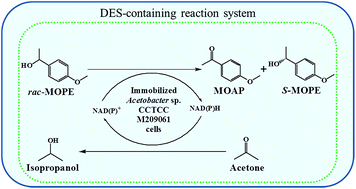Using deep eutectic solvents to improve the resolution of racemic 1-(4-methoxyphenyl)ethanol through Acetobacter sp. CCTCC M209061 cell-mediated asymmetric oxidation†
Abstract
As novel low-viscosity and environmentally-friendly reaction media, deep eutectic solvents (DESs) have gained much attraction in biocatalysis. In this study, various DESs were prepared and their effects on the asymmetric oxidation of racemic 1-(4-methoxyphenyl)ethanol (MOPE) catalyzed by Acetobacter sp. CCTCC M209061 cells to give enantiopure (S)-MOPE were examined. The best results were obtained with the DES [ChCl][Gly] and its concentration exerted a significant influence on the reaction, with the optimal content being 10% (v/v). In the [ChCl][Gly]-containing system, the substrate concentration was substantially increased (55 mmol L−1 vs. 30 mmol L−1) as compared with the [ChCl][Gly]-free aqueous system, while the residual substrate e.e. was kept as high as 99.9%. The good biocompatibility of [ChCl][Gly] with the cells and the improved cell membrane permeability in the [ChCl][Gly]-containing system could partly account for the clearly enhanced reaction efficiency.


 Please wait while we load your content...
Please wait while we load your content...